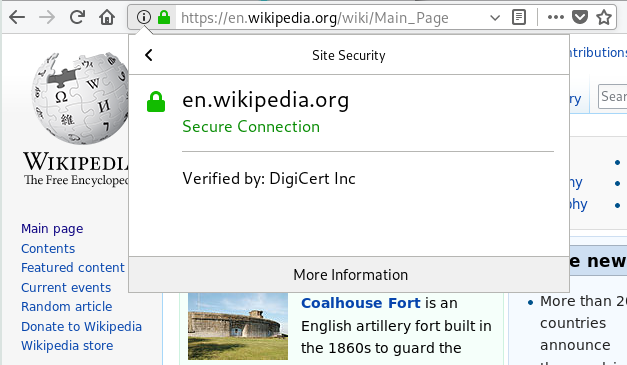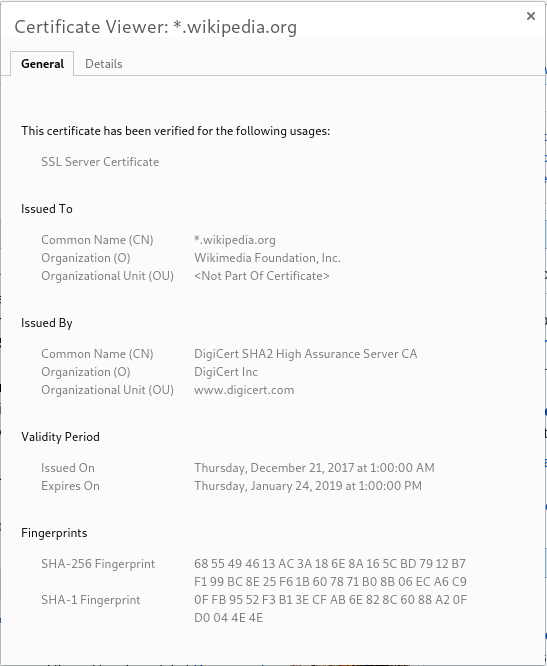HTTPS = HTTP + TLS
HTTP is an application-level protocol (see TCP/IP model)
- On top of the transport layer (TCP),
- Data is sent as text, no cryptographic protection,
- Middle boxes can intercept, read, block, alter data:
- Wiretapping on a local network,
- Sniffing/injecting wifi packets,
- Wiretapping internet backbones (e.g., transatlantic cables).
Transport Layer Security (TLS)
- Adds cryptographic protections above TCP layer: Confidentiality, Integrity, Authenticity, Forward secrecy.
- First standard: SSL 1.0, 1995 (Netscape Communications),
- Latest version: TLS 1.3, March 2018.
Cryptography
From Greek κρυπτoς + γραφειν (hidden writing)
Used for: secret messages, proving identity, signing digital data, electronic voting, digital cash, …
Security
- Based on mathematics:
- Based on widely believed mathematical assumptions, most of the time;
- A few constructions based on theorems.
- Based on computational hardness:
- Assumes adversary has bounded computational capacity / bounded success probability;
- Usually bounds are taken much larger than physically possible (e.g.: more computation time than the age of the universe / smaller probability than presence of active substance in homeopathic dilution).
- Based on secrets:
- keys, passwords must be securely stored.
Moral of the story
- Security is strong, but must be constantly reevaluated.
- Theft, operational security failures, law enforcement, social engineering are real threats!
Symmetric cryptography
- Known since the ancient times: YBH’IR QBAR VG NF N XVQ.
- Uses one shared key, known to all partners.
- Good for:
- secret messages (encryption),
- signing messages (message authentication code).
Asymmetric cryptography
- Known since the ’70s.
- Two keys:
- one secret key held by one party,
- associated public key known to everyone.
- Good for:
- secret messages (public-key encryption),
- proving identity (identification),
- signing messages (signatures),
- establishing shared keys (key agreement or key exchange).
Cryptographic guarantees in TLS
Confidentiality
- Messages are only intelligible by client and server;
- Achieved using symmetric encryption (e.g., AES).
Integrity
- Messages cannot be altered by third party;
- Achieved using symmetric encryption (e.g., HMAC, GCM).
Authenticity
- Client verifies identity of the server;
- Optionally: server verifies identity of the client;
- Achieved using asymmetric identification (e.g, RSA, DSA, ECDSA).
Forward secrecy
- Confidentiality maintained even if server/client keys are later compromised (e.g., stolen, or obtained by law enforcement);
- Achieved using asymmetric key exchange (e.g., DH, ECDH);
- Only mandatory in TLS ≥1.3.
How cryptograpy is used in TLS
Identification (authenticity)
- Server sends a certificate, containing its public key.
- Clients validate the certificate before starting conversation.
- Optionally, clients can send certificates too (rare).
Key exchange (forward secrecy)
- Client and server do a key exchange to establish a session key.
Symmetric encryption (confidentiality, integrity)
- Client and server use session key to exchange secret messages.
Certificates


-
Certificates prove ownership of a domain name:
I’m talking to someone who knows the secret key for en.wikipedia.org.
-
Certificates are signed by certificate authorities:
This has fact has been signed for by DigiCert Inc.
-
Root certificate authorities are stored in the browser:
My browser tells me to trust DigiCert.

TLS 1.3: (simplified) technical overview
-
Client sends ClientHello to server:
Hi, I speak TLS 1.2 and TLS 1.3. Here’s my ephemeral public key.
-
Server computes session key and responds with ServerHello:
Hi, I want to speak TLS 1.3 with you. Here’s my ephemeral public key, encrypted certificate and signature.
-
Client
- Computes session key,
- validates certificate,
- validates signature.
-
Client and server can start encrypted HTTP exchange using the session key.
Obtaining a TLS certificate
Certificate authorities verify that:
- You own the domain (you have write access to the site hosted at that domain),
- You know the secret key for your certificate,
- Optionally: you are who you claim to be in real life (address, phone number, etc.)
If all checks pass, they sign your certificate.
